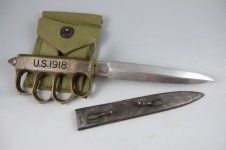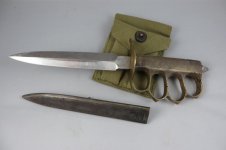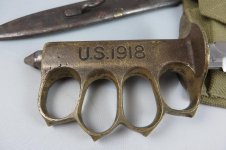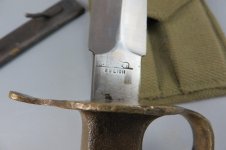-
Forum Update: We've upgraded the software to improve security, performance, and the overall experience.
👉 Read why we made the change | Support the Forum
You are using an out of date browser. It may not display this or other websites correctly.
You should upgrade or use an alternative browser.
You should upgrade or use an alternative browser.
WWI US 1918 Trench Knife - Au Lion French made....the real deal!!
- Thread starter THREEDFLYER
- Start date
Register to hide this ad
Top line cool...
Thought process behind the design is
pretty self explanatory.
Horrific ...but no doubt effective.
Thought process behind the design is
pretty self explanatory.
Horrific ...but no doubt effective.
Some serious damage could be done with a weapon like this.....would not want to be on the receiving end!
Was these successful ?
How long were they issued ?
How long were they issued ?
30-30remchester
Member
Was these successful ?
How long were they issued ?
These were issued with our first troops in WW1. A second type of knife had steel knuckles, wooden handle and a triangle style blade similar to old bayonets. These were in response to complaints with other knives. Seems the Huns wore very heavy coats and normal knives had a difficulty penetrating the heavy wool. The OP's knife has been heavily polished. As issue the blade and handles were flat black in color. The sheath is actually more rare than the knife. These were first issue during WWII. Many can be seen on belts of soldiers and Marines on Guadalcanal. The problem with these were the wide hilt. It was so wide and uncomfortable when on the belt, the hilt were ground flat so that one could roll over and squat without being gouged in the ribs. Nice piece of history.
CORRECTION: The French made US1918 Trench Knives did NOT have blackened blades, they were bright steel. I have done extensive research and the US Made version of this knife DID have blackened blades. The information on these is on the web to back this up.
However, this blade has been lightly sharpened at some point.
Yes, the sheath/scabbard's especially those fully in tact with the belt tabs are scarce.
I also have an original US made of the same design built by the L.F.&C. company also with the sheath/scabbard.
However, this blade has been lightly sharpened at some point.
Yes, the sheath/scabbard's especially those fully in tact with the belt tabs are scarce.
I also have an original US made of the same design built by the L.F.&C. company also with the sheath/scabbard.
Last edited:
30-30remchester
Member
CORRECTION: The French made US1918 Trench Knives did NOT have blackened blades, they were bright steel. I have done extensive research and the US Made version of this knife DID have blackened blades. The information on these is on the web to back this up.
Thanks for the additional info. I just assumed they were all blackened. You know what they say about assuming.
Thanks for the additional info. I just assumed they were all blackened. You know what they say about assuming.
I thought they were also until I did a bit of research......however, I agree that the blade has been polished and as I mentioned is lightly sharpened. These were not issued with a sharpened edge and could not open a can, cut a rope, etc. Pretty much made to impale an enemy and pummel them with the brass knuckle and point on the end of the handle. OUCH!!!
vonn
US Veteran
Nasty looking gear they used! That trench warfare must have been brutal for the troops.
Cardboard_killer
Member
Remember that 80% of the casualties were due to artillery (including gas and mortars). Then you have MGs, rifles, pistols and grenades. Then you get to the hand to hand casualties, which probably amounted to a percentage point or less.Nasty looking gear they used! That trench warfare must have been brutal for the troops.
Pretty much made to impale an enemy and pummel them with the brass knuckle and point on the end of the handle. OUCH!!!
Simply shooting me would have been good enough if I had been one of the enemy—no impaling or pummeling required.
Stevens
Member
The point at the end of the handle reminds me of the point on one of those emergency car glass break hammer tools. I guess it would do a job on a skull.I thought they were also until I did a bit of research......however, I agree that the blade has been polished and as I mentioned is lightly sharpened. These were not issued with a sharpened edge and could not open a can, cut a rope, etc. Pretty much made to impale an enemy and pummel them with the brass knuckle and point on the end of the handle. OUCH!!!
Steve W
The trench knife predates America's entry into the war. I have an account of a trench raid by British soldiers on June 30, 1916 where the raiders carried either a "persuader" (basically a mace, the club with a spiked ball) or a "knuckle knife".
"The knuckle knife is a dagger affair, the blade of which is about eight inches long with a heavy steel guard over the grip. This guard is studded with steel projections. At night in the trench, which is only about three to four feet wide, it makes a very handy weapon. One punch in the face generally shatters a man's jaw and you can get him with the knife as he goes down"
"The knuckle knife is a dagger affair, the blade of which is about eight inches long with a heavy steel guard over the grip. This guard is studded with steel projections. At night in the trench, which is only about three to four feet wide, it makes a very handy weapon. One punch in the face generally shatters a man's jaw and you can get him with the knife as he goes down"
Watchdog
Member
- Joined
- Apr 6, 2013
- Messages
- 12,511
- Reaction score
- 32,351
I'm just curious. When a collector finds something like that...the real deal...in good to really good condition...what would he expect to pay for something like that knife?
Just ballpark figures...not asking you what you paid for it.
Just ballpark figures...not asking you what you paid for it.
REM 3200
US Veteran
Thought you might enjoy this blast from the past......
I have the same knife and sheath. It was my Dad's,
issued to him when he enlisted in the Army in 1931.
He carried it through the first part of his WW2 service in the Pacific.
Later, as an officer, he carried a privately owned knife, a 6" Marble's.
I have it also.
I'm just curious. When a collector finds something like that...the real deal...in good to really good condition...what would he expect to pay for something like that knife?
Just ballpark figures...not asking you what you paid for it.
I sold an Au-Lion made 1918 with sheath a year or so ago in not quite as nice condition for $550 on GunBroker. The sheath is a huge plus and will greatly add to the overall value.
There is currently a US made 1918 by L.F.&C. up on GunBroker with 7 days left and the bidding is up to over $500 at this time.
I also own the US made version by L.F.&C. that has the sheath and that one has a bit of corrosion at the tip of the blade.....maybe from moisture, maybe from blood??? I will post photos later of that one.
Last edited:
Hey HARDWARE, thanks for the great photos!! That has inspired me to put together a photo with my WWI gear including the Trench Knife and my 1917 S&W!!
DWalt
Member
Some years ago when I was in London, I visited the Imperial War Museum. They had extensive WWI displays, among which was one showing numerous "handmade" weapons used in trench warfare. They looked like they came from the middle ages, all sorts and sizes of wooden clubs studded with spikes, pikes, sharpened shovels, axes, swords, etc. It was a brutal war.
Similar threads
- Replies
- 21
- Views
- 2K
- Replies
- 42
- Views
- 2K
- Replies
- 8
- Views
- 612
- Replies
- 31
- Views
- 1K
- Replies
- 2
- Views
- 388







